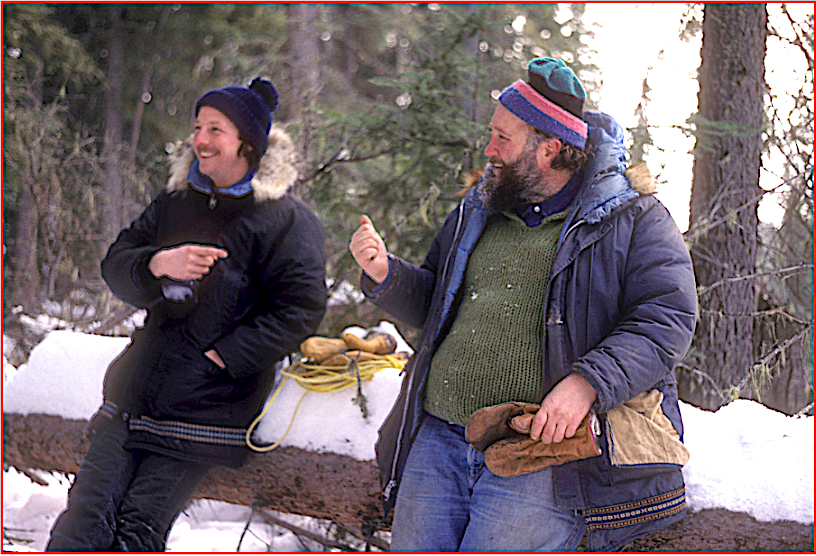In Memorium—John W. “Jack” Brink (1949-2023)
Jack Ives, with the assistance of information from W. J. Byrne and Quinton Crowshoe - 15 February 2023

Jack Brink and Emeritus Professor Charles Schweger in the Fort MacKay area, after conducting a coring expedition in the Birch Mountains.
The Department of Anthropology mourns the loss of John W. (Jack) Brink, who passed away in the early morning hours of January 30, 2023, at the University of Alberta Hospital. He was 74.
Born in Chicago to Bill and Jenny Lou Brink, Jack grew up in Connecticut where his father had become managing editor of the New York Daily News. Jack graduated from the University of Minnesota in 1972 and then joined our Department as an MA student, initially exploring the early period archaeology of the Ice-Free Corridor. By 1976, he had shifted his research focus to lithic use wear studies. Both Brink and Emeritus Professor Jack Ives shared MA committee members Emeritus Professors Cliff Hickey and Charles Schweger. Their thesis examinations were scheduled for one May afternoon in 1977. Ives’ research in the Birch Mountains of northern Alberta had been supported by the Archaeological Survey of Alberta, and then Director of the Survey, Dr. William J. Byrne, served as an external examiner for him. Defences concluded and introductions made, Byrne, Ives and Brink went for a celebratory drink. It was a fateful meeting—Brink would teach that summer as a sessional at Memorial University, but not before competing successfully for a new eastern slopes archaeologist position at the Archaeological Survey of Alberta, to which he would return later that summer. So began Jack’s four decade association with first the Archaeological Survey and later the Royal Alberta Museum, from which he would retire as Curator of Archaeology in 2018.
Jack returned to the Department as a PhD student in the 1980s. He was the driving force behind much of the 1980s work in developing the UNESCO World Heritage Site of Head-Smashed-In Buffalo Jump, and his dissertation research focused on detailed analyses on bison hunting and butchering strategies that were heavily influenced by his excavations in the camp and processing area in front of the jump. The completed work with appendices ran to more than 700 pages, but as Emeritus Professor Charles Schweger pointed out recently, left Jack dissatisfied because it lacked a human dimension. Jack shifted his focus, then throwing his energies into the Imagining Head-Smashed-In volume published by Athabasca University Press. The book was the winner of the 2009 Society for American Archaeology’s Public Audience Book Award, the 2012 Felicia A. Holton Book Award, Archaeological Institute of America, the 2009 Public Communications Award, Canadian Archaeological Association, and the 2009 City of Edmonton Book Prize.
Jack’s work at Head-Smashed-In and elsewhere in southern Alberta led to a long and close relationship with Blackfoot people, the North and South Piikani, Kainaiwa, and Siksikawa Nations. Distinguished Blackfoot ceremonialist Dr. Joe Crowshoe, Sr. bestowed the name Siipisstotokaan (Owl Head) upon Jack. Held in great esteem by Blackfoot communities, he was the recipient of an honour dance at Head-Smashed-In, as he retired in 2018.
Jack played a number of roles for the Department of Anthropology, invariably providing guest lectures on rock art (particularly the UNESCO World Heritage Site Writing-On-Stone) and communal bison hunting in ANTHR 256 (Alberta Archaeology) over the five decades in which that course has been offered through our department, and for course such as Plains Archaeology. From time to time, Jack offered critical advice to graduate students working on topics ranging from Reid Graham’s analysis of the Muhlbach bison kill (originally excavated by Emerita Professor Ruth Gruhn) to current PhD candidate Zhe Zhang’s work on a massive aurochs bone assemblage connected with a Neolithic site in Jilin, China. Indigenous and settler undergraduates and graduate students had a warm welcome at the Royal Alberta Museum when their research interests concerned Alberta collections held there, or when intern or other employment opportunities at the museum arose.
Among the many honours bestowed upon Jack were the Smith-Wintemberg Award (the Canadian Archaeological Association’s highest form of recognition for outstanding contributions), the John Dormaar Award by the Archaeological Society of Alberta, the Distinguished Service Award of the Plains Anthropological Society, and most recently, the Order of Canada (in which Jack was invested on December 14, 2022, most especially for his dedicated work with First Nations communities). He received an honorary doctorate from Ahtabasca University in 2012.
Jack is survived by his wife Erna Dominey, son Jonathan Thatcher, daughter Aaryn Bronson, and three brothers and their families (Bill [Margot Weiss], Bob [Cindy], and Tim [Pam]).
Jack will be keenly missed by his many colleagues and friends.